| Phyllostegia warshaueri | |
|---|---|
| Scientific classification | |
| Kingdom: | Plantae |
| (unranked): | Angiosperms |
| (unranked): | Eudicots |
| (unranked): | Asterids |
| Order: | Lamiales |
| Family: | Lamiaceae |
| Subfamily: | Lamioideae |
| Genus: | Phyllostegia |
| Species: | P. warshaueri |
| Binomial name | |
| Phyllostegia warshaueri Wawra | |
Phyllostegia warshaueri is a rare species of flowering plant in the mint family known by the common name Laupahoehoe phyllostegia. It is endemic to Hawaii, where it is limited to the island of Hawaii. [1] It is a federally listed endangered species of the United States.

The Lamiaceae or Labiatae are a family of flowering plants commonly known as the mint or deadnettle family. Many of the plants are aromatic in all parts and include widely used culinary herbs, such as basil, mint, rosemary, sage, savory, marjoram, oregano, hyssop, thyme, lavender, and perilla. Some species are shrubs, trees, or, rarely, vines. Many members of the family are widely cultivated, not only for their aromatic qualities, but also their ease of cultivation, since they are readily propagated by stem cuttings. Besides those grown for their edible leaves, some are grown for decorative foliage, such as Coleus. Others are grown for seed, such as Salvia hispanica (chia), or for their edible tubers, such as Plectranthus edulis, Plectranthus esculentus, Plectranthus rotundifolius, and Stachys affinis.

Endemism is the ecological state of a species being unique to a defined geographic location, such as an island, nation, country or other defined zone, or habitat type; organisms that are indigenous to a place are not endemic to it if they are also found elsewhere. The extreme opposite of endemism is cosmopolitan distribution. An alternative term for a species that is endemic is precinctive, which applies to species that are restricted to a defined geographical area.

Hawaii is the 50th and most recent state to have joined the United States, having received statehood on August 21, 1959. Hawaii is the only U.S. state located in Oceania, the only U.S. state located outside North America, and the only one composed entirely of islands. It is the northernmost island group in Polynesia, occupying most of an archipelago in the central Pacific Ocean.
This plant grows only on Mauna Kea and the Kohala Mountains of Hawaii, where its habitat is wet forests. There are four occurrences, for a total of under 20 individual plants. This liana can grow to 3 meters in length. It bears white flowers with pink upper lips. [1]

Mauna Kea is a dormant volcano on the island of Hawaii. Its peak is 4,207.3 m (13,803 ft) above sea level, making it the highest point in the state of Hawaii. Most of the volcano is under water, and when measured from its oceanic base, Mauna Kea is the tallest volcano in the world measuring over 10,000 m (33,000 ft). Mauna Kea is about a million years old, and has thus passed the most active shield stage of life hundreds of thousands of years ago. In its current post-shield state, its lava is more viscous, resulting in a steeper profile. Late volcanism has also given it a much rougher appearance than its neighboring volcanoes due to construction of cinder cones, decentralization of its rift zones, glaciation on its peak, and weathering by the prevailing trade winds. Mauna Kea last erupted 6,000 to 4,000 years ago and is now considered dormant. The peak is about 38 m (125 ft) higher than Mauna Loa, its more massive neighbor.

A liana is any of various long-stemmed, woody vines that are rooted in the soil at ground level and use trees, as well as other means of vertical support, to climb up to the canopy to get access to well-lit areas of the forest. Lianas are characteristic of tropical moist deciduous forests, but may be found in temperate rainforests. There are also temperate lianas, for example the members of the Clematis or Vitis genera. Lianas can form bridges amidst the forest canopy, providing arboreal animals with paths across the forest. These bridges can protect weaker trees from strong winds. Lianas compete with forest trees for sunlight, water and nutrients from the soil. Forests without lianas grow 150% more fruit; trees with lianas have twice the probability of dying.
The species is threatened by feral pigs, cattle, and introduced species of plants. [1]

The feral pig is a pig living in the wild, but which has descended from escaped domesticated individuals in both the Old and New Worlds. Razorback and wild hog are American colloquialisms, loosely applied to any type of feral domestic pig, wild boar, or hybrid in North America; pure wild boar are sometimes called "Russian boar" or "Russian razorbacks". The term "razorback" has also appeared in Australia, to describe feral pigs there.

An introduced species is a species living outside its native distributional range, but which has arrived there by human activity, either deliberate or accidental. Non-native species can have various effects on the local ecosystem. Introduced species that become established and spread beyond the place of introduction are called invasive species. The impact of introduced species is highly variable. Some have a negative effect on a local ecosystem, while other introduced species may have no negative effect or only minor impact. Some species have been introduced intentionally to combat pests. They are called biocontrols and may be regarded as beneficial as an alternative to pesticides in agriculture for example. In some instances the potential for being beneficial or detrimental in the long run remains unknown.






